Fiat stopped selling cars in the United States last year – but there’s still an Italian-brand car you can buy here (other than a Ferrari).
It’s the Giulia – one of two Italian cars made by Alfa Romeo.
Of course, it being Italian – and so something different – is only one reason to consider buying it.
Are there any others?
The Giulia is a compact-sized luxury sport sedan made by Alfa Romeo. It competes with other compact-sized luxury-sport sedans such as the Mercedes C-Class, Audi A4 and BMW 3 Series.
But what makes it different – other than being Italian and so not as commonly seen in the U.S. as the Benz C, BMW 3 and Audi A4? For one – and it’s a big one – it comes standard with a much stronger engine. Two-hundred-eighty horses vs. 201-255 in those others. For about the same – or even less – money vs. its Germanic rivals.
And you can get a Giulia with an engine so strong it’s almost surreal – 505 horses – in the Quadrifoglio version. This handily one-ups the M version of the BMW 3 Series sedan, which tops out at 473 horses. The strongest version of the Mercedes C-Class sedan (the C43) summons a distant 402 horsepower.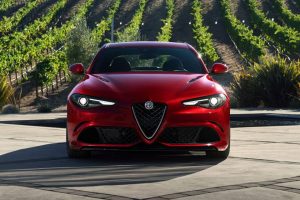
It’s also rear-drive, which the Audi A4 isn’t. This matters – to people who like the superior balance/handling that the rear drive layout delivers.
But you can get AWD – if you want it.
Giulia prices start at $44,280 for the base Sprint trim. The next-up Ti trim adds a panorama sunroof, heated seats and a larger (18 inch) wheel/tire package. It stickers for $46,320. For a sportier Giulia, there’s the Veloce – which adds a limited slip rear differential, faster steering, bolstered seats and an upgraded brake system with red powder-coated calipers.
If you want even more sportiness, the $55,420 Estrema adds an adaptive suspension system, wider (19 inch) wheels with short sidewall sport tires and black powder-coated brake calipers set off with white “Alfa Romeo” script. A 14 speaker Harman Kardon audio system is also includes, along with carbon fiber and aluminum interior trim.
The ultimate version of the Giulia, however, is the $79,760 Quadrifoglio – which replaces the otherwise-standard 2.0 liter turbocharged (and 280 hp) four that comes in other Giulias with the 505 horsepower V6 mentioned above – plus everything that comes with the Estrema and a torque vectoring differential, plus lightweight carbon fiber body panels and an “active aero” front splitter system that enhances high-speed stability.
What’s New
A Lusso package is available for the Ti trim that bundles the 14 speaker Harman Kardon audio system with special two-tone leather seats.
The Estrema trim is also new.
Standard engine is more powerful than rivals’ standard engines.
Multiple trims/lots of options allow for more personalized choices.
Something different for a change.
What’s Not So Good
Like other compact-sized luxury-sport sedans, the back seat is tight (35.1 inches of legroom) and the trunk is small (13.4 cubic feet).
Standard 2.0 liter turbo four is stronger than others – but it’s still the same general type of engine you’ll find in others.
It might be hard to find an Alfa dealer in your area.
Like so many new cars, the Giulia comes standard with a turbocharged 2.0 liter four cylinder engine. This type (and size) of engine has become the standard engine in so many new cars – across all makes, models and price points – because it’s not too big – and not too small. Not too big – in order to not use too much gas and so comply with federal fuel efficiency requirements, which are now so high as to require economy car mileage (30-plus MPGs) from even luxury-sport sedans like this Alfa.
And also so as to reduce the amount of gas (C02) it produces – also in order to comply with federal requirements that are designed – ultimately – to force engines of all sizes out of the showroom in favor of electric motors.
But, the Giulia’s 2.0 liter turbo four does differ from most in one key respect. It is significantly more powerful than the standard 2.0 liter turbo fours that are standard in rival luxury-sport sedans like the Mercedes C300, the BMW 3 Series and the Audi A4.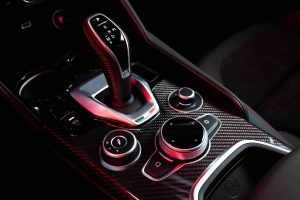
The Alfa’s 2.0 liter four makes 280 horsepower – as opposed to 255 from the BMW and Benz fours. The Audi A4’s standard 2.0 liter turbo four makes only 201 horsepower.
An eight speed automatic transmission is standard. You can choose either rear wheel drive or (optionally) all-wheel-drive. Either way, this Italian stallion gets to 60 in just over 5 seconds. And it gets 24 city, 33 highway – only a few MPGs less than many economy cars with a lot less than 280 horsepower.
But there’s also something else. Something very different.
That thing being the Giulia’s available twin-turbocharged V6. This ones makes 505 horsepower, which is a really big number. It’s even bigger – in terms of how impressive – when you consider that the Alfa’s V6 isn’t much larger than the standard 2.0 liter four. The V6 displaces a mere 2.9 liters – making it one of the strongest, smallest V6s out there (or ever). To get a sense of how strong this little engine is, consider that the 6.4 liter V8 that powers the ’23 Chrysler 300 C I test drove last week makes only 485 horsepower in spite of being more than twice the size.
Not surprisingly, the Quadrifoglio version of the Giula is extremely quick. Zero to 60 in 3.8 seconds. To get a sense of just how quick that is – consider that a 700-plus horsepower Dodge Charger Hellcat, with a supercharged V8 more than twice the size of the Alfa’s V6, is only slightly quicker.
Perhaps even more surprising is the Alfa’s modest thirst relative to its power: 17 city, 25 highway. This is slightly better mileage than the 6.4 liter V8 Hemi Chrysler 300’s 15 city, 24 highway. The 505 hp Alfa also has a highway range just shy of 400 miles – and you’ll only need to stop and wait for about five minutes to refuel and be ready for another almost-400-miles of driving.
As opposed to the 30-plus minutes you’d have to wait at a “fast” charger to instill even half a “tank” of range in an electric car such as the Tesla Model 3.
Somehow, the Giulia’s standard 2.0 liter turbo four doesn’t sound like all the other 2.0 liter turbo fours. Probably because Alfa wants you to hear it.
And not hear something else.
There is less sound deadening of the engine, which is a good thing in a car meant to appeal to people who like to hear the engine. And the sounds you hear are authentic – as opposed to the sounds electronically generated and piped into the cabin through the audio system to make you think there’s something else under the hood.
BMW, for instance, pipes the sounds of its six into some of its cars equipped with the four. Toyota pipes the sound of the V8 you can no longer get into the cabin of the V6-only Tundra.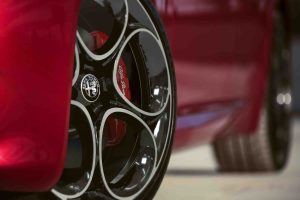
Alfa lets you hear what you’ve got – and the sound is good.
Some are under the mistaken impression that four cylinder engines are fundamentally economy car engines – and sound it.
Ask the owner of a Miata about that.
Or a Japanese sport bike.
The Alfa SOHC four makes convincingly Italian sounds, especially when first started up. You might think someone forgot to install the catalytic converters. The sound accompanies you – at rising pitch – all the way past the 5,500 RPM tachometer-indicated redline to 6,200 RPM – at which time the rev limiter kicks in. 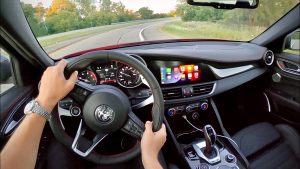
There’s even what sounds like some wastegate snap – though its just the baffles of the active exhaust blipping open under wide-open throttle.
The 306 ft.-lb. of torque produced by the four is maintained from 2,000-4,800 RPM – which gives the mid-range and part-throttle punch of a much larger engine. You can alter some of the drivetrain’s feels – such as shift points and sharpness of throttle response – by selecting any of the three drive modes, Dynamic, Natural and Efficiency.
Relative to the others in the class, the Giulia is, in summary, the more passionate car – as an Italian car ought to be. It’s not quicker – with the four – than a Benz C300 or BMW 3. But it is more emotionally arousing. Part of this may have to do with the close-fitted cockpit feel of the car, especially when you’re behind the wheel. Before you are gauges – not displays. Big tach on the left, speedo to the right – and clear physical separation from the LCD screen set off farther to the right.
Clearly, the Apps are less important than the drive.
And for even better sounds and feels, take a spin in the twin-turbo’d Quadrifoglio. You’ll be glad you did.
At The Curb
It’s nice to see something different, too.
There’s no mistaking the Giulia for something else – because it doesn’t look like all the rest. From any angle, there are differences. That was also true of the late, unlamented Pontiac Aztek as well. But those were the wrong kind of differences.
Elegant and aggressive at the same time – and clearly not from Germany. Not that there’s anything wrong with that. The point is precisely that it’s not from there – nor trying to look as if it were.
Just the right squat, too. And the upward cant of the Quadrifoglio’s four exhaust tips is pure automotive art.
It looks pretty sharp under the hood, too – which is another difference. You can see the dual throttle bodies of the V6 and much of the engine, too. Probably because there’s something worth looking at, for once.
Inside, you will find that different dash layout described earlier, with sports car gauges rather than cell phone-emulating LCD displays.
It all fits like a pair of Bruno Maglis.
But, the fit can be tight – for those in the back. This is equally true of all the models in this class, however. The Giulia – like the Benz C300 and BMW 3 and Audi A4 – are compact-sized sedans (at 182.5 inches long overall, the Giulia has exactly the same footprint as a Toyota Corolla) and for that reason have compact-sized rear seat accommodations and trunks. But the Giulia hasn’t got appreciably less than its rivals in the rear seat legroom department (35.1 inches vs. 35.2 for the BMW 3, 35.7 for the A4 and 36.0 for the Benz C300) and it actually has a fairly large-for-the-class (13.4 cubic foot) trunk that is larger than the BMW 3’s 13 cubic foot trunk, the C300’s 12.6 cubic foot trunk and the A4’s 12 cubic foot trunk.
And you’re getting a lot more in terms of the intangibles. The sounds and feels.
The having something that’s different, for a change.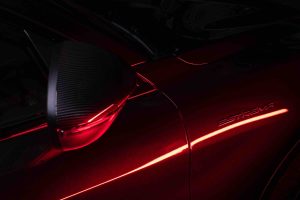
The Rest
Alfa offers many options for further differentiation, among the highlights being the two-tone leather interior treatment that comes with the Lusso package. The new Estrema is a kind of all-but-Quadrifolgio, featuring many of the mechanical upgrades – as far as the suspension and brakes – as well as many of the interior/trim upgrades, such as carbon fiber facings, aluminum pedals and a serious-looking set of inward-staggered 19 inch black powder coated wheels with the “signed” Alfa calipers visible through the big holes for the airflow.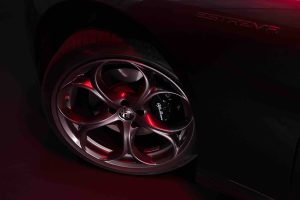
The Quadrifoglio is eligible for ultra-high-performance 15.1 inch carbon-ceramic brake upgrade, too.
One thing you cannot get, however, is the Giuletta – which is the wagon version of the Giula that’s not sold in the United States. That’s a shame because it would eliminate the practicality problem by tripling the available usable space inside and make this exotic car a feasible family car, too.
The Bottom Line
Something different for a change?
And for once?
. . .
If you like what you’ve found here please consider supporting EPautos.
We depend on you to keep the wheels turning!
Our donate button is here.
If you prefer not to use PayPal, our mailing address is:
EPautos
721 Hummingbird Lane SE
Copper Hill, VA 24079
PS: Get an EPautos magnet or sticker or coaster in return for a $20 or more one-time donation or a $10 or more monthly recurring donation. (Please be sure to tell us you want a magnet or sticker or coaster – and also, provide an address, so we know where to mail the thing!)
My eBook about car buying (new and used) is also available for your favorite price – free! Click here. If that fails, email me at EPeters952@yahoo.com and I will send you a copy directly!


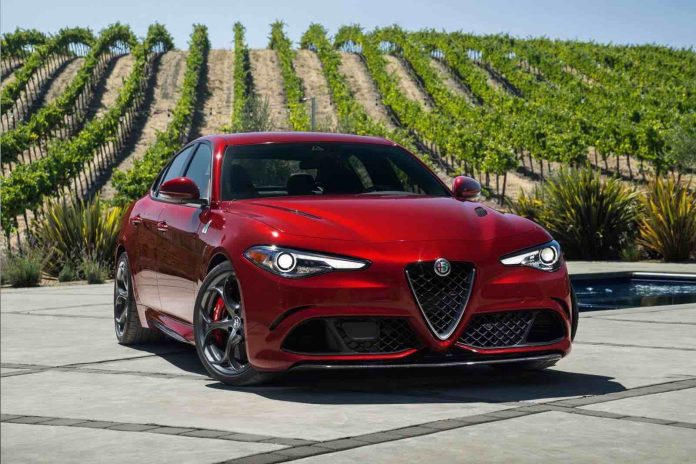

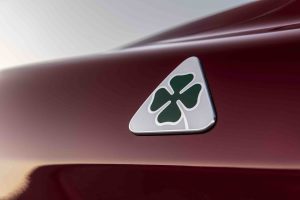


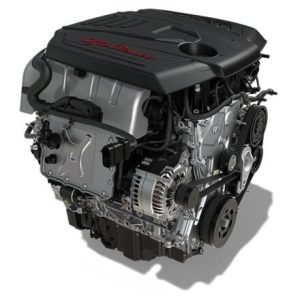
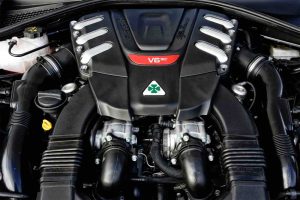

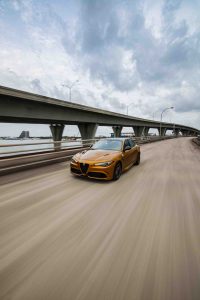
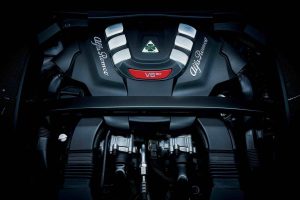


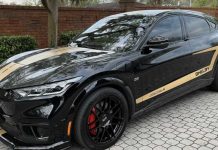





Jeremy Clarkson like testing one so much he bough one.
https://vimeo.com/202661050
In a not too distant future, the museum Curator states,
“And here, folks, we have a remarkable example of the “Red Barchetta”, that the band Rush sang about in eeriely prescient song of the same title”, in front of the V6 Guilia
‘Quadrifoglio’ means ‘four-leaved.’
Thus the curious clover symbol (second photo down).
Not the same thing (or meaning) as Eric’s clover decals.
If you want more room you can get the Stelvio…the Alfa Romeo Quadrifoglio SUV…it was the quickest SUV in the world at the ring in 2018….
VIDEO: Alfa Romeo Stelvio Quadrifoglio – Fastest SUV Run at Nürburgring in 2018…now #5
https://www.supercars.net/blog/video-alfa-romeo-stelvio-quadrifoglio-fastest-suv-run-nurburgring/
These Are The Fastest SUVs Around The Nürburgring Track
https://www.hotcars.com/these-are-the-fastest-suvs-around-the-nrburgring-track/#porsche-macan-8-27
Hi Anon,
At the height of Covid when we weren’t supposed to travel, I traveled to Lanzarote which is a small island very dependent on tourism, of which there weren’t any. So the car rental guy upgraded me to one of these – which I have to say is one of the funnest cars I have ever driven. Yes its not perfect and there things where corners were clearly cut – but it certainly had a personality, much more than other family SUVs.
I almost bought this car. I tried to but it didn’t work out. yes, it has questionable reliability, but like Eric says below:
‘Sometimes it’s worth it’, and I agree.
The only reason I didn’t was the closest dealer was 1hr away, and I couldn’t do it. I decided that 1hr away for just me is a price i could pay, but i called the dealer and asked if they had rental cars. No, so now I had to put out two people for 2-3 hrs if the car ever needed service. no sale.
Great review Eric, you basically solidified how good/fun I thought this car was.
Alfa Romeo Giulia’s Ferrari-Sourced Engine….Powered by a Ferrari-developed 2.9-liter twin-turbo V6
This explains the Giulia’s performance; two Ferrari engineers; one for the engine and one for the chassis.
nurburgring laptimes…..the Alfa Romeo is quick….quicker then the Plaid which has 1000 hp….the Alfa only has 505 hp…..
7:32 Alfa Romeo Giulia Quadrifoglio
7:33 Porsche 911 GT3 RS (997.2)
7:34 Nissan GT-R (2011)
7:34 Lexus LFA Nürburgring Package
7:35 McLaren 650S Spider
7:35 Tesla Plaid
7:37 Chevrolet Camaro Z/28 (2014)
7:38 Ferrari 458 Italia
7:38 Chevrolet Corvette C6 ZR1
7:40 Bugatti Veyron 16.4
7:40 Lamborghini Murciélago LP640
Tesla Plaid vs Alfa Romeo Giulia Quadrifoglio
The Ferrari engineers did a great job designing the engine and suspension on the Alfa Romeo Giulia Quadrifoglio…and it has perfect balance…… 50/50 weight distribution…a perfectly balanced car with Ferrari engineering…a great driver’s car…
The Tesla has bad brakes, can’t corner and horrible high speed stability….
Alfa Romeo Giulia Quadrifoglio $79,760 ……. Ferrari engineering…at far lower price…..like a 4 door sedan Ferrari for $79,760….best deal ever…..
Tesla Plaid $120,000……looks way over priced…
Curb weight
Tesla Plaid 4932 lb
Alfa Romeo Giulia Quadrifoglio 3862 lb
The Tesla has 100% more hp and only 28% more weight….but it is slower……..
Top speed…..
Tesla Plaid 162 mph….
Alfa Romeo Giulia Quadrifoglio…191 mph
nurburgring laptimes…..the Alfa Romeo is quick….quicker then the Plaid which has 1020 hp….the Alfa only has 505 hp…..
nurburgring laptimes
7:32 Alfa Romeo Giulia Quadrifoglio
7:35 Tesla Plaid
The Alfa could quite likely become a collectible car in 30 years….The Tesla will be worth nothing in 10 years when the $22,000 battery is dead….lol
Alfa Romeo a strong name…
QUADRIFOGLIO’S WINNING LEGACY…..The emblem of worldwide triumphs
Name any major race, circuit or championship, and you will find the Quadrifoglio emblem figuring high in their halls of fame: Alfa Romeo gained the first ever GP World Championship in 1925, and the first two Formula 1 titles in 1950 and 1951. These are just a few of the many achievements in a winning streak that boasts 5 world championships, and hundreds of Italian and European titles. These victories are more than just a part of Alfa Romeo’s history; they have become integral components of every Quadrifoglio model.
The Tesla has bad brakes, can’t corner and horrible high speed stability….
Car and Driver…
Model S plaid high-speed behavior, which, frankly, was terrifying. It wanders in its lane, with lots of slop on center in the steering that doesn’t have anything to do with the yoke. Putting it in the sport steering setting helped a little, but it’s like Tesla neglected to dial in its high-speed steering and handling behavior. This is not what you want when traveling two-thirds the distance of a football field every second. Tick. Tick. Every other car that’s in the same conversation—from the Porsche Taycan to the Bugatti Chiron—is unerring and locked on its lane at 150-plus mph.
Bad brakes………. Even in our standard braking tests—five consecutive stops from 70 mph, and three from 100 mph with more space between—the Plaid’s brake hardware was already starting to cry uncle. Not only did they smell like they were on the way out, there was a warning message that popped up on the dash notifying us of their imminent demise. And our test regimen isn’t nearly as severe as hot-lapping on a racetrack.
this plaid kept locking up the brakes after going over a bump and then crashes backwards off the race track….fun to watch….
https://insideevs.com/news/549607/tesla-plaid-crashes-track-brakes/
I love the look of the car but if I got one, I’d definitely go for the extended warranty or lease rather than buy.
Hey Eric, Why don’t automakers do more 2.9 V6’s?
Hi Rich,
I think this particular V6 was sourced from Ferrari; GM used to build a 2.8 liter V6 (it didn’t make 505 hp). There used to be a variety of V6s available. But government regs have all-but-killed them off.
This V6 is very light….it might be a good engine swap into a Boxster, a Super 7, a Radical or a GR86…..
A Detailed Look At The Alfa Romeo Giulia Quadrifoglio’s Engine
https://www.hotcars.com/alfa-romeo-giulia-quadrifoglio-engine/
This car is absolutely beautiful. It’s one of the few that I would want to own. The turbo 4 is plenty fast enough and the thing handles like it’s glued to the road. It is so tight that it can sense a reverse camber turn and keep you planted in. It’s pretty nice on the inside as well.
Too bad to hear about the reliability. I know that they are not known for that, but they should have learned some lessons.
Apart from its glorious engine, the Giulia Quadrifoglio also sports an array of underlying mechanical aids that make it a complete joy to drive. It features double-wishbone front suspension and multilink vertical rod suspension in the rear, with active dampening that changes based on the selected drive mode.
The super sedan also comes with active torque vectoring that re-distributes torque and power in real-time, as well as a nearly perfect 50/50 weight distribution. When combined with the Giulia Quadrifoglio’s precise and responsive steering, the sedan becomes one of the most capable handlers in its segment, which is a big reason why it’s so agile around the racetrack.
If I could have found one, a QV was really appealing to me. In a world of homogeneous cars it had some character. It has the ubiquitous 2.0t and ZF8 but in its favor everyone seems to think it’s a great chassis. Seemingly you can lease a Ti for peanuts.
I was excited by this article – until I saw turbo 2
What a let down. Like hearing Ben Stein repeating Bueller.
Maybe I’m just getting fussy and sick of everything needing to be turbo charged.
My Asian girlfriend tells me that us Europeans are like European cars. We look good, loud, and powerful, yet unreliable and sometimes fussy. I tell her Asian women are like Asian cars, cheap and easy to maintain.
That’s what I tell my Asian girlfriend as well.
I had forgotten Alpha even still existed. I think they may be rarer in the upper midwest than Ferarris. The Italians have always made fun stuff, and always seem to get a lot more horsepower out of tiny displacements than others.
The last Italian car I owned was a (hideous baby crap green) mid 70’s 124 sedan with automatic that a buddy gave me after he broke the engine (I dont even remember how). In the process of putting it back together I bent the vacuum modulator in the trans. On the first test drive I hit 8000 RPM on that crazy little twin cam trying to make it shift. It held together! Viva Italia!
An inexpensive way to get a small Ferrari 4 door sedan….
Listen to the Alfa Romeo Giulia’s Ferrari-Sourced Engine….Powered by a Ferrari-developed 2.9-liter twin-turbo V6
This explains the Giulia’s performance; two Ferrari engineers; one for the engine and one for the chassis.
The V6…. It is definitely a Ferrari engine, scaled down from the V8, although it may be callibrated to Alfa Romeo tastes.
the engine was assembled in Ferrrari’s engine plant in Modena / not at Alfa’s production plant in Cassini.
https://www.autoguide.com/auto-news/2015/06/listen-to-the-alfa-romeo-giulia-s-ferrari-sourced-engine.html
Listen to that engine….that is why you should never buy an EV….they are dead, no life, no feeling, no joy…
That’s the point of EV’s, more soulless than a 2000’s automatic corolla or camry
They can’t get rid of all cars, and there are ways to beat the system, plus ’24 happens and we get a repube, they’ll probably throttle down this EV crap anyway, so it’s not all lost.
Dr Meat Toboggan mentioned that they’re a bit unreliable, but that’s also part of the charm now. Forums probably figured out what the weak links are, Aftermarket has a fix, and I’d trust one over an EV anyday
Man, I hope that you’re right. I don’t hold up much hope for that as the last 5 elections, 2017, 18, 19, 20, and 22 were stolen.
I’ve owned two Alfas, a 63 coupe Giulia Sprint 1600 and a 69 Spider 1750 ”Inizione” (fuel injected). Wish I’d never sold them, what fun and great memories – if you understood the quirks and were handy with a wrench they made really fun cars! My 2019 Euro trip included Northern Italy and my daughter indulged me with a great day at the Alfa museum near Milan, there were my cars – “Dad, are you tearing up over cars?”
Got spoiled at a young age driving these sports cars that handled and drove so well. I’m intolerant of cars that just don’t drive “right”. Looking at you, 2018 Jeep Grand Cherokee!
I’m not much for Oriental cars but the exception is Mazda, a Mazda 6 evokes that driving fun of yesteryear sort of a poor man’s Alfa.
One of my neighbors has a Alfa Spyder, a beige automatic one. Despite that, I’d love to drive one.
Wonder what other classic italian cares there are for this half pizza to drive
Here is a Fiat X1/9 race car it weighs 550 kg/ 1300 lb powered by a 1.5 litre 217 hp bike engine….it is very quick
watch it on the track
https://www.youtube.com/watch?app=desktop&v=MiwxGrRv06w&fbclid=IwAR3Ay8FWA1If-t1AWAKHf7dEKp0T10SVXZbld06OmWwo39aGk6uSdDHjGYA
If you liked the Alfa Romeo Guilia and it’s 2.0 lt 4 cyl turbo engine
Here is an Alfa Romeo 4C with a 700 hp modified version of that engine….it sounds great…
The 4C weighs 2000 lb the same as a Lotus Elise, a Porsche Cayman is 3000 lb, the C8 Corvette is 3600 lb……
https://www.youtube.com/watch?v=TpFtHlJmL4k
Car and Driver did a long-term test of this car and the mechanical maladies were legendary. I think the car spent most of its 40k miles in the shop. I’ve never seen a modern car that was that dreadfully unreliable. That’s ok if you’re like me and have another vehicle you can drive, but if the Alfa, great looking and sounding as it is, is your daily driver, good luck.
It’s a running joke with my car-loving brother in law that we text each other when we see a Gigulia actually on the road and not on the bed of a flatbed wrecker.
Hi Dr.
True enough. But sometimes, it’s worth it. My TA has it foibles, too. But every time I drive it I am reminded why I kept it…
Yep, warts and all I’m sorry I ever sold the 63 and 69.
The 63 had a five speed believe that was the first year. Fun zipping up to a Porsche on the freeway in 3rd, he’d hit the gas in his 3rd, then I’d keep winding it out then shift twice, Porsche drivers look was priceless.
ice vehicles are far more reliable then EV’s and can be fixed…the old analog ice vehicles are better and far easier to fix…..EV’s just instantly brick….go to zero residual value….can’t fix/too expensive to fix/ten year lifespan then junk…..
I read the 2.0t didn’t have the same problems though.
I would be weary of Italian Engineering, but 2.0t’s are universal and fine. The 2.9tt was the one they had the 40k long term review with.
the list of issues with EV’s is far longer then the worst ice vehicle ever made…..
far more reliable then an EV and it can be fixed…EV’s just instantly brick….go to zero residual value….
Family Stunned After Learning That Used Electric Ford Focus’ Batteries Cost More Than The Car Itself
Avery Siwinski got her second-hand Ford Focus Electric for $11,000; six months later, she was looking at a $14,000 battery replacement…not including labour…..but later found out that batteries weren’t even available for the car.
a 17-year-old who was excited to have a car to get her to and from school. The family paid $11,000 for the car, which had 60,000 miles
Siwinski had only had her Focus Electric for six months before the dashboard lit up with a warning message……And all the sudden it stopped working.”………Turns out, this is a pretty common problem for this particular car,
Ford Auto Nation in Pinellas County offered $500 to buy the car as-is, …..hahaha…..
https://www.carscoops.com/2022/07/family-stunned-after-learning-that-used-electric-ford-focus-batteries-cost-more-than-the-car-itself/
‘It also revs to 7,400 RPM.’ — eric
Half a century back, muscle car V8s typically claimed about one horsepower per cubic inch. That is, a 427-cubic-inch Chevy big block would report a (probably exaggerated) 425 hp.
Displacing 177 cubic inches, Alfa Romeo’s 2.9 liter V6 is cranking out (505/177) = 2.85 hp per cubic inch … almost triple the specific output of a lumbering old V8 of the Before Times.
Is that good? Well, it’s impressive from a technical standpoint. One doubts whether automotive engineers of the 1960s would have believed it possible in a stock, street-driven vehicle. However, being backed against the wall by ‘regulators’ with badges and guns can elicit unexpected ingenuity in the interest of survival.
Nevertheless, an all-aluminum V6 (not inherently balanced like an I6) that can spin to 7,400 rpm with a fairly aggressive 20 psi of turbo boost ought to induce a sense of caution among those who have observed always beautifully designed, but rarely the most reliable, Italian cars over the decades.
Will this little mill survive for 100,000 miles without burning up those turbos or some of its valves? One hopes so. But I’d do some research on its probable longevity … and price out the extended warranty just in case.
This explains the Giulia’s performance; two Ferrari engineers; one for the engine and one for the chassis.
First!
Also remember that unlike the germans, Alfa built the Quadrifolgio first and then later the 2 liter, rather than the 3 series and then the M3 for example, so you’re getting a better deal performance wise as well